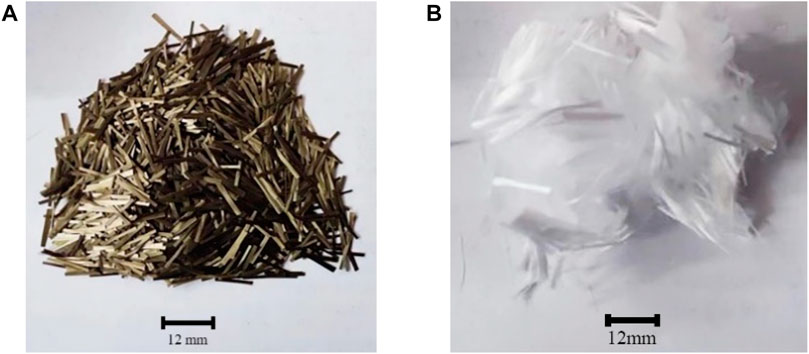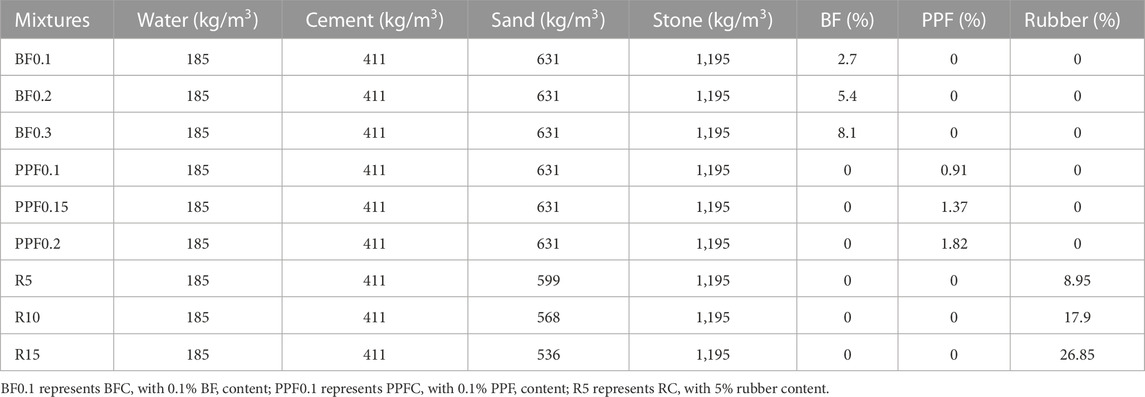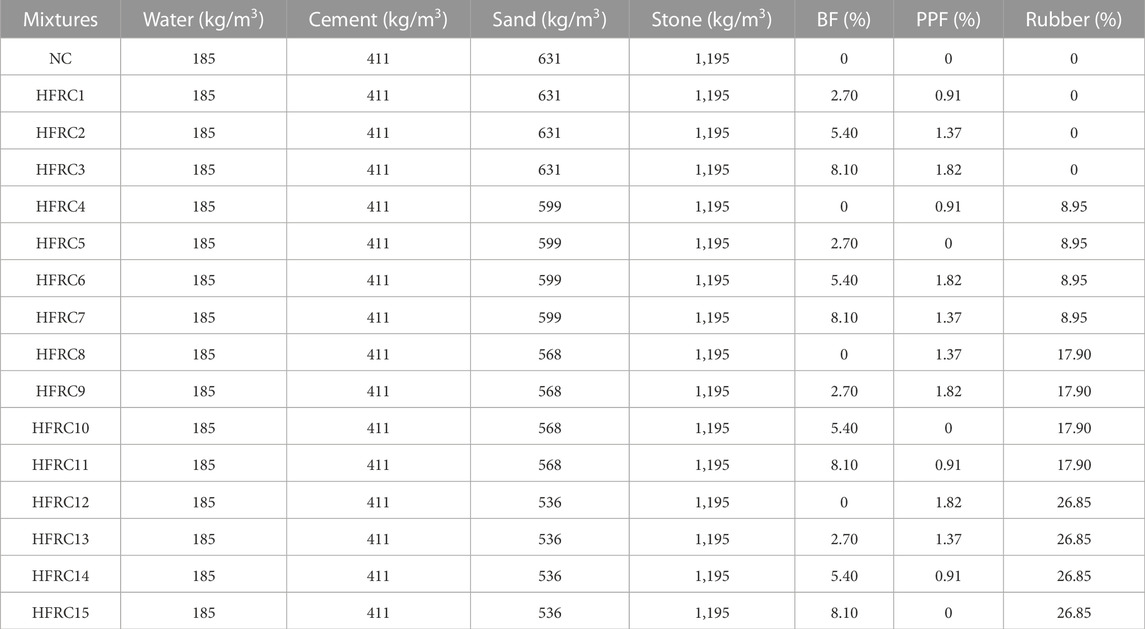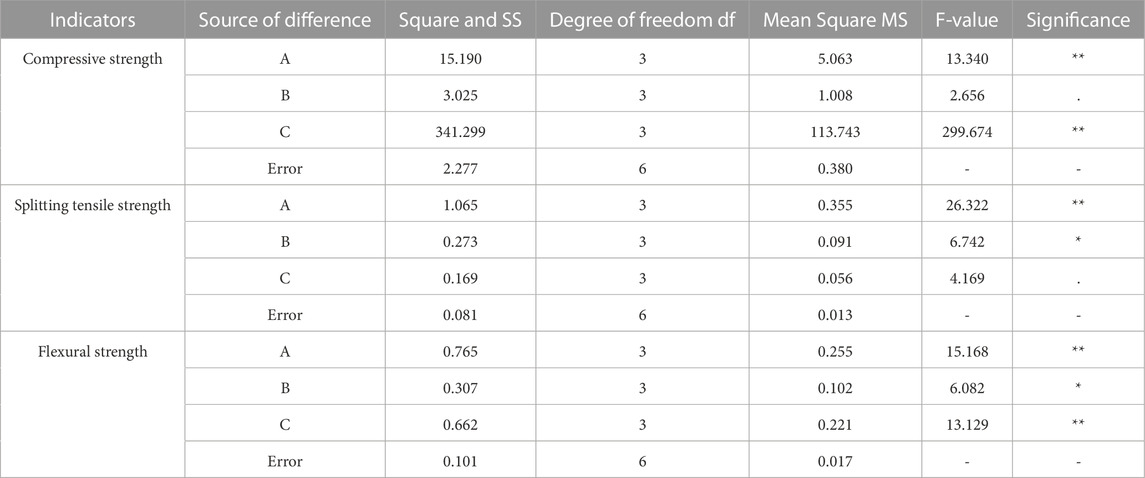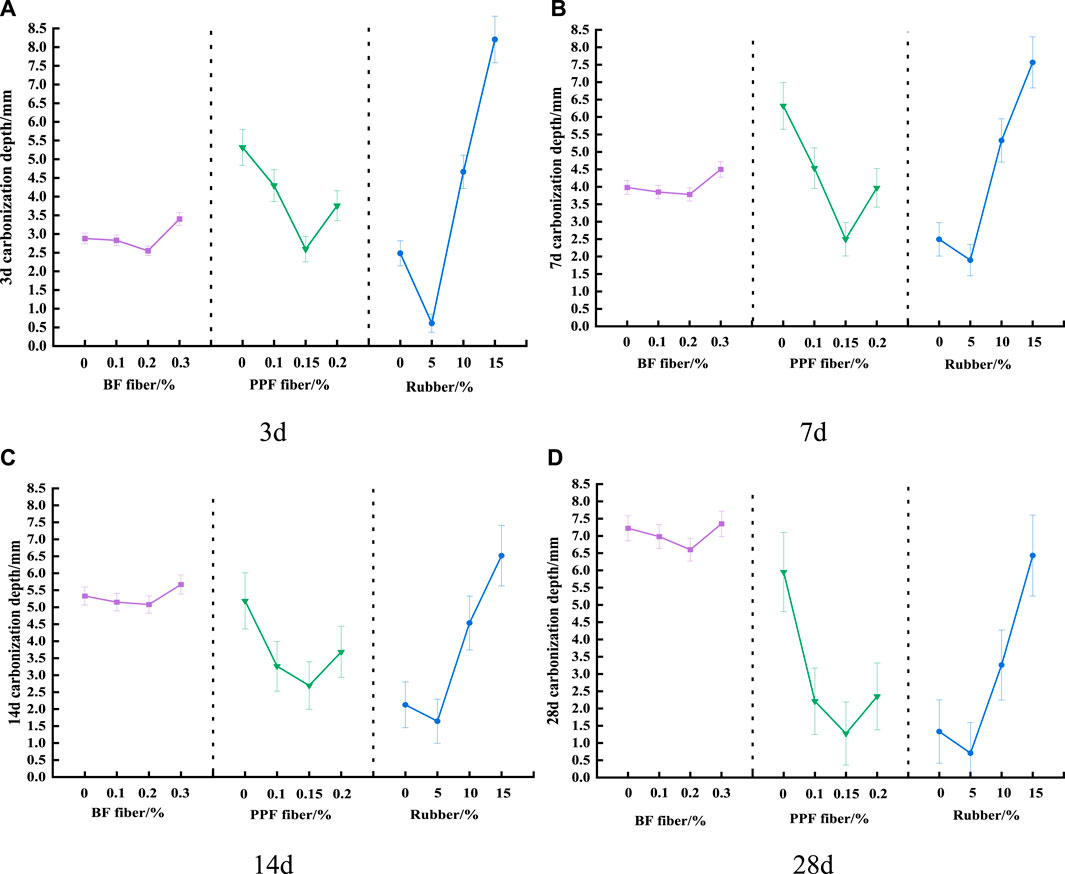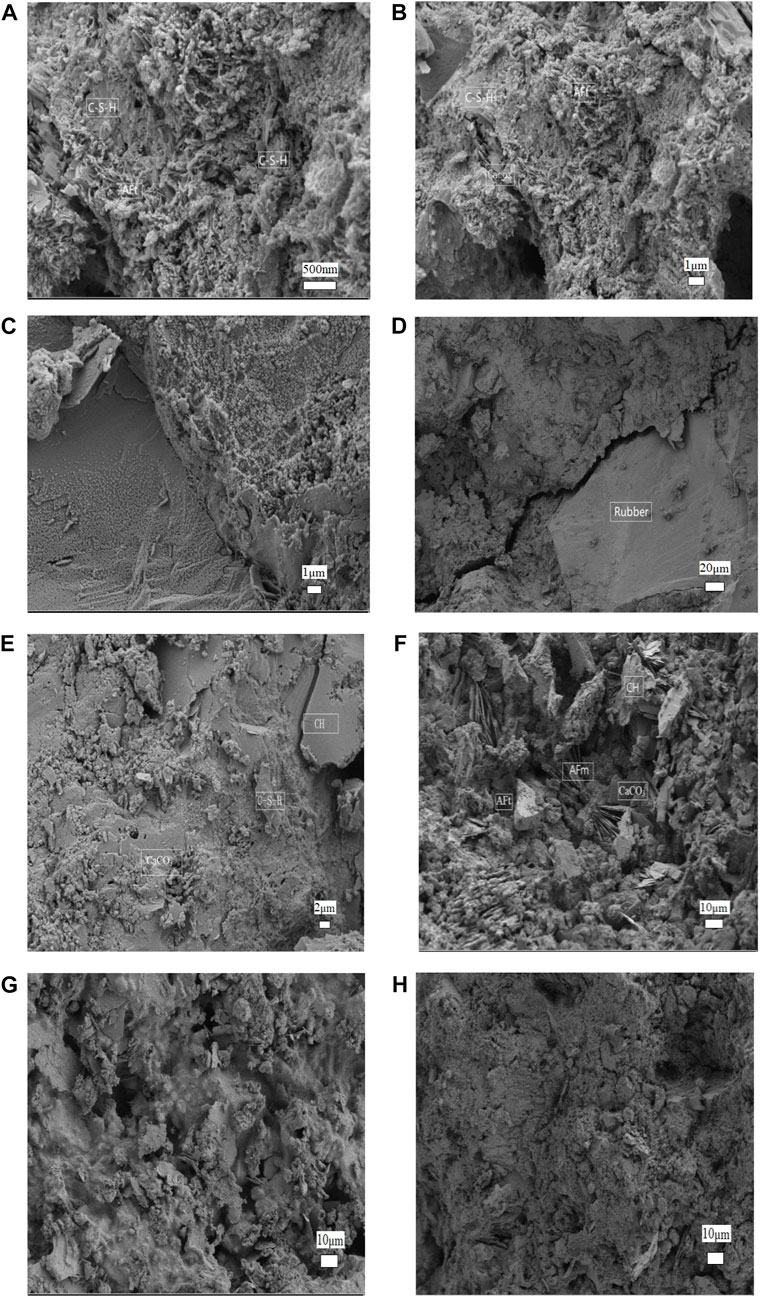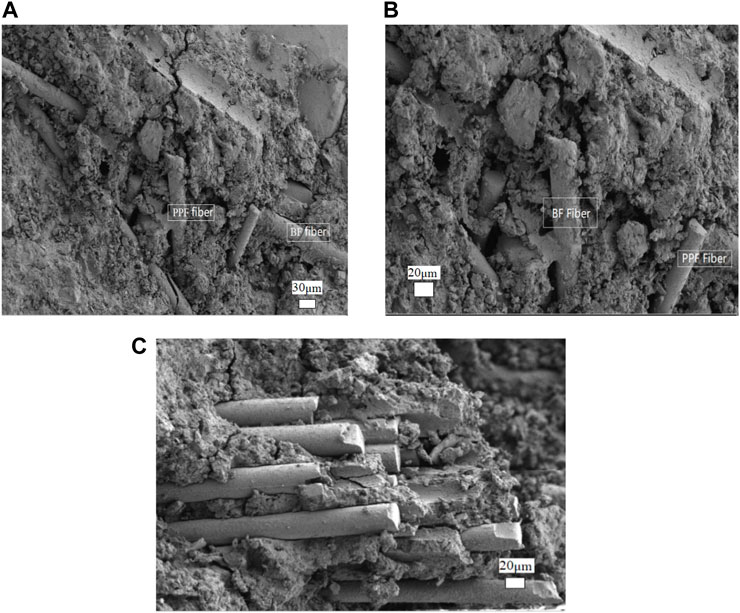- 1Liaoning University of Technology, Jinzhou, China
- 2Engineering Technology Department of Logistics Management Office of Liaoning University of Technology, Tianjin University, Tianjin, China
- 3Logistics Management Division, Liaoning University of Technology, Jinzhou, Liaoning, China
The accumulation and incineration of waste tires have caused great damage to the environment. Therefore, recycling waste tires efficiently and economically has become an important issue in protecting world resources and the environment. In this study, 5%, 10%, and 15% rubber particles were used to replace fine sand in concrete, and basalt fibers (0.1%, 0.2%, and 0.3%) and polypropylene fibers (0.1%, 0.15%, and 0.2%) were added to rubber concrete to prepare hybrid fiber rubber concrete (HFRC). The experiments investigated the changes of mechanical properties of basalt (BF), polypropylene (PPF) fibers, and rubber particles when they were blended into concrete respectively, and the degree of influence of each factor on the mechanical and carbonation resistance of HFRC was investigated based on the orthogonal test. The results show that the rubber concrete’s mechanical and carbonation properties are improved to varying degrees after adding hybrid fibers. When the basalt fiber content is 0.2% and the polypropylene fiber content is 0.15%, the overall mechanical properties of HFRC reach the best state. When the basalt fiber content is 0.2%, the polypropylene fiber content is 0.15%, and the rubber content is 5%, the carbonation resistance of HFRC is the most ideal. In addition, the microstructure of HFRC was observed by scanning electron microscope.
1 Introduction
With the rapid development of the global construction industry, traditional concrete has been unable to meet some projects due to its brittleness, poor toughness, and easy cracking. Therefore, the project’s general trend is to develop in the direction of green and efficient. The Chinese market has a huge amount of rubber loss, and the number of used tires discarded each year is among the highest in the world. According to the report of the tire industry project of the World Business Council for Sustainable Development, about 1 billion tires are produced globally every year, and about 4 billion waste tires have been accumulated (Sienkiewicz et al., 2012). In 2019, 6.8 million tons of waste tires were recovered in China, down 3.7% from the previous year (Cao et al., 2013). As an organic polymer elastic material, the gas composition produced by rubber combustion is complex, containing some harmful gases (Zhang and Rao, 2011; Thomas and Gupta, 2016), including polycyclic aromatic hydrocarbons, SO2, NO2, etc., and burning the remaining powder will pollute the soil. Therefore, the accumulation and incineration of waste tires have caused great damage to the environment. Therefore, recycling waste tires efficiently and economically has become an important issue in protecting world resources and the environment.
In the ordinary concrete to add rubber particles to replace some of the fine aggregates prepared and the concrete is called rubber concrete (Rubber Concrete, referred to as RC). It has the characteristics of low mechanical strength, low density, good impact resistance, good toughness, good sound insulation, and high resistivity (Wang et al., 2014; Lv et al., 2015; Guo et al., 2017; Si et al., 2017; Wen and Liu, 2018; Wang W. N., 2019). Using rubber to replace part of the aggregate reduces the amount of natural aggregate and helps to solve the large accumulation of waste tires. At the same time, rubber concrete has more advantages than ordinary concrete in some special fields, so it has also attracted scholars in recent years.
Su et al. (2015) found that the smaller the rubber particle size, the less the strength loss. The small size rubber filled the internal pores of the concrete, improved the internal stress concentration, and then improved the bending strength. Fattuhi (Fattuhi and Clark, 1996) studies have shown that small rubber particles have a higher degree of influence on compressive strength. Yilmaz (Yilmaz and Degirmenci, 2009) believes that when rubber aggregate replaces fine aggregate by 20% in concrete, it has higher flexural strength than traditional concrete, and there will be no brittle failure after cracking. When the rubber replacement rate increases from 20% to 30%, the flexural strength of rubber aggregate concrete decreases, and the drop becomes smaller and smaller with the reduction in particle size. However, Skripkiūnas et al. (2009) found the opposite conclusion: the larger the rubber particle size, the lower the strength loss. In addition, Richardson et al. (Li et al., 2020) showed that although the strength of concrete decreased after adding rubber, there was no clear relationship between compressive strength and rubber particle size. Pham et al. (2020) believed that the carbonation depth of rubber aggregate concrete is higher than that of ordinary concrete, and increasing with substitution rate. Garros (2006) used rubber aggregate to replace 25% of fine aggregate (0 ∼ 4 mm) and coarse aggregate (4–10 mm), respectively. The carbonation depth decreased by 5.2 mm after replacing fine aggregate and 4.2 mm after replacing coarse aggregate. The results show that the effect is relatively good when replacing fine aggregate. Wang (Wang T., 2019) found that when the water-cement ratio is 0.45, the carbonation depth is proportional to the rubber substitution rate, In contrast when the water-cement ratio is 0.55, it shows a different law. Bravo (Bravo and de Brito, 2012) and Guptaa et al. (2014) believed that there was a linear relationship between carbonation depth and rubber substitution rate. Huang et al. (2021) studied the effect of the chloride environment and freeze-thaw cycle on the appearance and mechanical strength of concrete with a rubber particle size as the main factor and concluded that the smaller the rubber aggregate size, the more significant the strength of the test block will change in the low-temperature environment. The microscopic analysis of the scanning electron microscope shows that with the increase in freeze-thaw times, the macropore ratio in ordinary concrete is higher than that in rubber concrete. Ye (2013) found that the addition of rubber to concrete improved its frost resistance, the rubber material with small particle size had better frost resistance, and the outer surface of the test block was relatively small. Richardson et al. (RichardsonCoventryEdmondson et al., 2016) found that using rubber particles as additives in concrete can minimize the loss of compressive strength and provide maximum freeze-thaw protection.
The fiber has good crack resistance and strengthening and toughening effects, which can inhibit the formation and expansion of internal cracks in concrete. Basalt Fibre (BF) is a new type of fiber with good performance, low cost, good environmental protection, good insulation, and good corrosion resistance, which can be evenly distributed in concrete. An appropriate amount of basalt fiber can improve the mechanical properties of concrete, significantly improve its toughness and failure mode, improve the toughness index and fracture performance, and alleviate the brittleness of concrete (Li et al., 2020). Researchers Jiang (JiangFanWu et al., 2014) and Alnahhal (Alnahhal and Aljidda, 2018) both concluded that basalt fiber concrete made by adding BF to concrete has high splitting tensile strength and flexural strength. Su (Su and Xu, 2023) tested BFC with different BF doses against sulfate erosion and showed that the fibers improve the internal structure of concrete to enhance the load-bearing and deformation capacity and improve the compactness, thus improving the erosion resistance of BFC. Li et al. (Li and Gao, 2022) found that the appropriate amount of basalt fibers produced bridging and hoop effects, which inhibited the development of cracks and could improve the compressive and splitting tensile strength of concrete.
Polypropylene Fiber (PPF) has the characteristics of simple production, low cost, thermal conductivity, and acid and alkali resistance, and has been widely promoted. Ju et al. (2018) added PPF to reactive powder concrete and found that the mechanical properties of the concrete were all improved with PPF dosing between 0.3% and 0.9%. Zhang (2019) investigated the hydromechanical properties of base concrete in depth by properly controlling the long-term curing and ageing period of base concrete and increasing the viscosity content of PPF fibers. The results showed that the addition of fiber content greatly improved the mechanical compressive movement strength and extensibility of the base concrete, and improved the mechanical compressive resistance and toughness of the base concrete. Liang (Liang and Liu, 2012) et al. selected different mechanical strength values and sizes of materials using PPF fibers in turn, and conducted strength measurement tests after cracking of concrete walls of various building materials under the same mechanical strength size conditions in turn, respectively. The results showed that the addition of polypropylene fibers of different thicknesses could effectively prevent concrete cracking, delay the formation of cracks in the hardening stage of concrete, and greatly improve the crack resistance of concrete. Ccasani Jean (Ccasani et al., 2021) et al. studied the effect and regular changes of two different lengths of PPF fibers on the compressive strength and flexural strength of reinforced concrete aggregates, and the experimental results showed that the fiber concrete solid The number of cracks and the degree of cracking formed in the early stage of the slab had greatly improved compared to plain concrete. Moreover, the addition of PPF fibers to the concrete specimens improved the ductility of the concrete specimens, resulting in higher strength of the solid slab elements.
Adding an appropriate amount of fiber to cement mortar can compensate for the strength loss caused by rubber particles. Therefore, BF fiber and PPF fiber are mixed and added to rubber concrete to prepare a new hybrid fiber rubber concrete (HFRC).
The primary purpose of this paper is to study the effects of different fiber and rubber substitution rates on the mechanical and carbonation properties of concrete. The mechanical properties and carbonation resistance of rubber concrete and fiber-reinforced rubber concrete were evaluated. In the context of rapid social development, the contradiction between the deterioration of the natural environment and the shortage of natural resources is becoming more and more acute, and the green low-carbon and energy-saving social development mode has become a necessary path for the future sustainable and rapid development of countries all over the world. In order to protect the ecological environment and waste utilization, the use of an appropriate amount of waste tire rubber particles instead of natural sand and add the right amount of mixed fibers to prepare fiber rubber concrete, not only can improve the brittle properties of ordinary concrete, but also can make the concrete to obtain light weight, elastic shock absorption, noise and sound reduction, heat insulation and heat preservation, deformation of energy consumption and good durability and other new properties for the application of rubber concrete in the field of road, railroad and bridge engineering to provide a reference basis.
2 Experimental programs
2.1 Materials
In this paper, P.O42.5 ordinary Portland cement produced by China Bohai Cement Co., Ltd. is used. Its chemical composition conforms to the Chinese GB175-2007 standard (Yan et al., 2007). The fine aggregate adopts natural river sand, the fineness modulus is 2.72, the water content is 3.06%, the apparent density is 2643 kg/m3, and the bulk density is 1,070.4 kg/m3. A continuous grading mechanism breaks the coarse aggregate. The particle size range is 5–25 mm, the apparent density is 2650 kg/m3, the bulk density is 1,166.2 kg/m3, and the crushing index is 8.9%. Coarse aggregate and fine aggregate align with the requirements of China’s GB50086-2001 standard (Cheng and Duan, 2001). The water for mixing and curing is local domestic water, the pH value is 6.9, and the chloride and sulfate content is 250 mg/L, which aligns with China’s JGJ63-2006 standard (Ding et al., 2006). The BF fiber and PPF fiber used in this experiment were manufactured by China Tianlong Basalt Continuous Fiber Co., Ltd. and China Tianyi Engineering Fiber Co., Ltd. respectively. The appearance is shown in Figure 1, and the specific parameters are shown in Table 1 and Table 2; China Dujiangyan Huayi Co., Ltd., manufactured the rubber particles used in the test. The appearance is shown in Figure 2, and the indicators are shown in Table 3.
2.2 Methods of test
The experiment mainly explores the influence of BF, PPF fiber, and rubber particles on concrete. Based on the orthogonal test, the mechanical and carbonation resistance of HFRC are comprehensively analyzed, and microscopic analysis of HFRC are carried out. According to the Chinese GB/T50081-2002 standard (Rong et al., 2002), the mechanical properties of the concrete test block made of two sizes, a 100 mm × 100 mm × 100 m cube test block in 5000 kN universal testing machine for compressive and splitting tensile strength test; the specimen with a size of 100 mm × 100 mm × 400 mm was used for the flexural test. According to the Chinese GB/T50080-2016 standard (Leng et al., 2016), the prism specimens with a test size of 100 mm × 100 mm × 300 mm were used for the carbonation depth test. The carbonation depth test was carried out in a standard carbonation box. The test was carried out according to the Chinese GB/T50082-2009 standard (Leng et al., 2009). All the specimens above were cured in the standard curing room for 28 days.
3 Mechanical test
To explore the hybrid fiber rubber concrete properties, the experiment was designed to investigate the effect of three factors acting alone on the mechanical properties of concrete, rubber particles with 5%, 10%, 15% replacement of fine sand, BF, PPF fiber admixture of 0.1%, 0.2%, 0.3% and 0.1%, 0.15%, 0.2%, respectively. The concrete mix is shown in Table 4.
3.1 Results and analysis
The influence of various factors on the mechanical properties of concrete is shown in Figure 3. After adding BF, PPF, and rubber particles, the overall mechanical properties of concrete specimens were significantly improved, and the original obvious brittle failure characteristics were changed. With the increase of BF and PPF fiber content, the specimens’ compressive strength, splitting tensile strength, and flexural strength increase first and then decrease. This is mainly because when the content of BF and PPF is too high, it is easy to appear “agglomeration” phenomenon, which makes the ability of the specimen to withstand external forces worse, resulting in a decrease in the mechanical properties of the model. With the increase in rubber replacement rate, the overall mechanical properties of the models gradually decrease. The main reason can be attributed to the low strength of the rubber material itself compared with the fine aggregate, the weak bearing capacity, and the relatively poor bonding capacity with the cement mortar. There are many soft surfaces between rubber and cement mortar, resulting in a decrease in overall strength. Secondly, the rubber itself has the air-entraining effect, and the air content inside the specimen will increase with the increase of rubber content, resulting in a decrease in the overall compactness of the concrete.
3.2 Comprehensive analysis of mechanical properties of HFRC
To analyze the comprehensive influence of BF (A), PPF (B), and rubber (C) on the mechanical properties of HFRC under different dosages, the orthogonal test was designed, and the test results were analyzed by range and variance statistical analysis. The concrete mix ratio is shown in Table 5.
3.2.1 Range analysis
The range analysis of HFRC is to calculate the influence of BF fiber (A), PPF fiber (B) and rubber (C) on the test results of HFRC. The orthogonal table of three factors and four levels is selected for orthogonal test, and these effects are expressed in the form of charts. Then, the maximum and minimum values are found by range analysis, and the influence degree of each factor on the test results of HFRC is determined.
The results of range analysis of mechanical properties of HFRC are shown in Table 6. In the table, K1 is the sum of the strengths of HFRC under level 1, K2 is the sum of the strengths of HFRC under level 2, K3 is the sum of the strengths of HFRC under level 3, and K4 is the sum of the strengths of HFRC under level 4. k1 is the average value of each strength of HFRC under level 1, k2 is the average value of each strength of HFRC under level 2, k3 is the average value of each strength of HFRC under level 3, k4 is the average value of each strength of HFRC under level 4. R is the extreme difference. Rubber has the most obvious effect on the compressive strength of HFRC can be found from the test results, BF fiber has a great influence on the splitting tensile and flexural strength of concrete, while PPF fiber has no significant effect on the mechanical properties of HFRC. It shows that the content of rubber particles and BF fiber is an essential factor affecting the mechanical properties of HFRC.
The changing trend of mechanical properties of HFRC is shown in Figure 4. When the content of PPF is 0.15%, the compressive strength and splitting tensile strength of HFRC increase by 2.58% and 5.86%, respectively, compared with those without PPF. When the content of BF is 0.2%, the compressive strength, splitting tensile strength, and flexural strength of HFRC increase by 5.93%, 15.64%, and 8.99%, respectively, compared with those without BF, and the increase is the largest. The elastic modulus of the rubber material itself is very low, and the strength is significantly lower than that of stone and sand. In addition, the bonding force between the rubber and the cement-based contact surface is poor, and it is easy to form a soft surface. The addition of fibers makes the pores between the rubber and the cement-based filled by fibers, replacing the original rubber-cement-based loose contact surface, and the compactness is improved (Wei, 2023).
3.2.2 Analysis of variance
The degree of influence of each factor was analyzed by the statistical calculation of the analysis of variance of HFRC specimens, which is shown in Table 7. When the influence degree of representative test factors on the results is “extremely significant”, expressed as “**”. When the degree of influence of the representative test factors on the results is “more significant”, expressed as “*”. When, the degree of influence of the representative test factors on the results is “not significant”, expressed as.
It can be seen from the variance analysis that the influence of PPF content on the splitting tensile strength and flexural strength of HFRC is “more significant”. On the other hand, the influence of rubber content on the compressive strength and flexural strength of HFRC is great, and the influence on the splitting tensile strength is not obvious. BF content is the most critical factor affecting the compressive strength, splitting tensile strength, and flexural strength of HFRC. Taken together, the variance analysis test data showed consistent results with the range analysis data.
4 HFRC carbonation performance test
Based on the orthogonal test designed in Table 5, the HFRC prepared with different amounts of basalt fiber (A), polypropylene fiber (B) and rubber (C) was combined according to the designed factor level, 16 groups of different mix ratios, and 3 specimens were made in each group, total 48 specimens. After the curing was completed, the carbonation test was carried out according to the Chinese GB/T50082-2009 (Leng et al., 2009) standard. After 3d, 7d, 14d, and 28d rapid carbonation, the carbonation depth was detected. The HFRC was subjected to microscopic detection and analysis by SEM electron microscopy.
4.1 Carbonation results and analysis
The visualization of the cross-section after carbonation and the results of the carbonation depth test are shown in Figures 5, 6. The test results show that no matter what content design level, the carbonation depth is improved compared with NC, but the improvement of carbonation depth is not obvious with the increase of rubber content. Under different carbonation ages, the appearance of carbonation depth of HFRC specimens is shown in Figure 8. Among them, the pink-filled area represents the uncarbonated area, and the light gray area outside the specimen represents the carbonation area. On the 7th day of carbonation, the carbonation area is concentrated at the four edges, and the area is small; when the carbonation was carried out on the 14th and 28th days, the carbonation area gradually spread from the four edges to the center, and the area occupied was increasing. It can be seen that the carbonation depth is positively correlated with the carbonation time, so the carbonation age is an important reason to determine the carbonation depth.
The influence trend of the carbonation depth of HFRC is shown in Figure 6. When the rubber content is 5% and the BF fiber content is 0.2%, the carbonation depth of HFRC at different ages increases with age, and the carbonation depth of the specimen increases. When the rubber content is 5% and the PPF fiber content is 0.15%, the carbonation depth of HFRC at different ages also increases gradually, indicating that age has a great influence on the carbonation of HFRC. When the content of BF fiber is 0.2% and the content of rubber is different, the carbonation depth of HFRC at different ages increases with the increase of rubber content. When the content of PPF fiber is 0.15%, the results are consistent, indicating that the carbonation depth increases with the increase of rubber content. When the rubber incorporation is zero, the incorporation of BF and PPF fibers can reduce the carbonation depth of concrete and improve the carbonation resistance of HFRC to the greatest extent, indicating that the incorporation of fibers plays a positive role in the carbonation of concrete.
The results show that the optimal dosage of BF fiber is 0.2%, and the carbonation depth at different ages is reduced by 11.46%, 5.03%, 4.70%, and 8.59%, respectively, compared with that without dosage. The optimal content of PPF fiber is 0.15%, and the carbonation depth is reduced by 28.40%, 28.54%, 15.09%, and 20.37%, respectively, compared with the amount of undoped PPF. When the rubber content is 5%, the maximum decrease is 27.73% compared with the undoped. Therefore, when the content of BF, PPF fiber, and rubber is 0.2%, 0.15%, and 5% respectively, the carbonation resistance of HFRC is the best.
Observing the trend of carbonation depth in Figure 6, the carbonation depth of HFRC decreased first and then increased. The reason for this is that the specimen has a tendency to reduce the carbonation rate significantly in the early stage of carbonation due to the continuous absorption of CO2 and water for reaction, which makes the matrix volume larger, and the reaction products fill some voids with appropriately doped rubber particles. However, the surface properties of rubber particles (organic materials) are far different from those of cement matrix (inorganic materials), resulting in certain pores between rubber particles and cement matrix, which is manifested by the weak interfacial bonding between them. At the same time, rubber particles increase the interfacial transition zone between coarse aggregate and cement matrix, thus weakening the interfacial bond between concrete matrix and coarse aggregate, so the internal structural compactness of concrete decreases, making concrete more inhomogeneous and thus affecting the carbonation process (Ruan and Li, 2012). Through the results, The influence degree of the three factors on the carbonation depth of HFRC at 3d, 7d, 14d, and 28d is C > B > A. The rubber content is a significant factor affecting the carbonation depth of HFRC, and PPF fiber has a good effect on improving the carbonation resistance of HFRC. It can be seen from the data that although adding an appropriate amount of fiber can delay the carbonation rate of HFRC, with the increase of fiber and rubber substitution, the improvement effect of carbonation depth is general. Because the fiber diameter is small and the specific surface area is large, an appropriate amount of fiber will be evenly distributed in the matrix to form a fiber grid after mixing with the mortar. When the cracks in the cement mortar are interlaced with the fibers, the contact interface between the fiber and the cement matrix will form a bond stress to connect the concrete matrix around the crack, effectively resisting the stress concentration at the crack tip when the external load is applied, and preventing the crack from expanding. At this time, the tensile strength and toughness effect brought by the fiber is greater than the weak surface effect. When the fiber content is too large, it is easy to agglomerate, resulting in weak internal surfaces and reduced compactness (Wang, 2014). Secondly, due to its air-entraining properties, the rubber content increases the internal air content of the concrete, and the pores become larger, accelerating the CO2 invasion.
4.2 Microstructure investigation and analysis
Concrete itself is a heterogeneous material. After adding rubber particles, there will be no chemical reaction. Instead, these rubber aggregates will be wrapped by the surrounding cement stone. Due to the material properties of rubber itself, rubber concrete has more heterogeneous material interfaces than ordinary concrete. The contact interface between rubber and concrete has repulsive force, and the connection between these interfaces is not close, and there are more voids (Ruan and Li, 2012). The microstructure of the surface and fibers of fractured concrete specimens with a 10% rubber admixture in HFRC was investigated by scanning electron microscopy (ZEISS GEMINI300, Germany).
4.2.1 Effect of rubber particles on the carbonation properties of HFRC
Figures 7A,B are magnified images of the rubber concrete before carbonation under the electron microscope, which can clearly distinguish the cement hydration the products of, such as C−S−H and AFt, which are thinly covered on the surface of the matrix. Figures 7C,D are the microscopic morphology of the interfacial transition zone of the internal material of ordinary concrete and rubber concrete after magnification under the electron microscope. The bonding between mortar and aggregate in ordinary concrete is close and the interface is linear. The occlusion of rubber and aggregate in rubber concrete has visible pores, and there are also obvious pores in mortar, which shows that there are more weak channels in rubber concrete and they are more vulnerable to CO2 erosion. Figures 7E,F show the images of the specimen after 3 days of carbonation. From the enlarged image, it can be seen that there are many CH plate crystals, AFt, a small amount of CaCO3, and hexagonal flake AFm crystals in the concrete after carbonation for 3 days. Some holes are faintly visible, which may be because the rubber particles are not compatible with the concrete aggregate and some CO2 enters the matrix. The CaCO3 filled the honeycomb holes left by the gap of the rubber boundary (Yuan, 2013). Figures 7G,H shows the morphology of the specimen after 28 days of carbonation. The general pattern in the figure can no longer identify C-S-H and other hydrates, and the gap in the transition zone increases obviously. Therefore, it is easier for CO2 to enter the whole concrete, with more paths and accelerated carbonation damage. The main reason can be attributed to the fact that during the carbonation process, CH releases chemically bound water to react with CO2 to form CaCO3. The volume of CaCO3 is larger than that of CH, and it squeezes each other with the rubber interface to produce larger cracks. In addition, the products of cement hydration, such as C−S−H and AFt, will shrink with the progress of carbonation, and cracks will occur on the surface of concrete, which expands the channel for CO2 to enter the matrix and increases carbonation damage (Yao and Bai, 2022). This indicates that the higher doping of rubber particles has an inverse negative effect on enhancing the anti-carbonation property.
4.2.2 Effect of fibers on the carbonation properties of HFRC
The microstructure of fibers incorporated into rubber concrete was analyzed by scanning electron microscopy. Figure 8A shows that the fiber is uniformly and disorderly distributed in the concrete matrix, and the fiber and the matrix are closely connected, which is the premise that the fiber can enhance the carbonation performance of rubber concrete. Figure 8B shows that the fiber spans the cracks in each gap. As the carbonation progresses, the cracks in the concrete matrix will become wider and larger. The effective fiber overlap between the cracks can bear a part of the tensile stress, relieve the stress concentration, delay the crack development, and slow down the carbonation process. Figure 8C shows that too much fiber content agglomerates inside the matrix, and the fiber can no longer effectively exert its reinforcing properties. On the contrary, the pores become larger due to aggregation, which reduces the carbonation resistance of rubber concrete.
5 Conclusion
The effects of two fiber types on the mechanical properties and carbonation resistance of RC were investigated. The following conclusions can be drawn based on the experimental results and analysis.
(1) Adding BF and PPF fibers into concrete respectively, the compressive strength of plain concrete is not significantly improved, and the splitting tensile strength and flexural strength are greatly improved. With the increase of BF and PPF content, concrete specimens’ compressive strength, splitting tensile strength, and flexural strength increased first and then decreased. The improvement effect of two kinds of fibers on the mechanical properties of plain concrete is stronger than that of a single fiber.
(2) With the increase in the replacement rate of rubber particles, the mechanical strength of rubber concrete shows a decreasing trend. However, incorporating fibers in rubber concrete can compensate for the strength loss caused by some rubber. An appropriate amount of fibers can be evenly distributed in cement mortar to form a three-dimensional support structure, which can improve the splitting tensile strength.
(3) The influence of PPF fiber content on the splitting tensile strength and flexural strength of HFRC is not significant. The influence of rubber content on the compressive strength and flexural strength of HFRC is great, and the influence on the splitting tensile strength is not obvious. When BF fiber content is 0.2% and PPF fiber content is 0.15%, the mechanical properties of HFRC are the best.
(4) The early carbonation depth of HFRC is high, and the later carbonation depth is reduced. The influence degree of carbonation depth is rubber content > PPF fiber content > BF fiber content. Adding an appropriate amount of fiber and rubber can delay the carbonation rate of HFRC, but with the increase of fiber and rubber substitution, the carbonation depth of HFRC decreases first and then increases. When the BF fiber content is 0.2%, the PPF fiber content is 0.15%, and the rubber content is 5%, the HRFC has the best carbonation resistance.
(5) Scanning electron microscopy tests were conducted on HFRC to analyze the carbonation mechanism and the role of fiber reinforcement from a microscopic perspective.
Data availability statement
The original contributions presented in the study are included in the article/supplementary material, further inquiries can be directed to the corresponding author.
Author contributions
LK: Investigation, data curation, writing-original draft. LX: Supervision, conceptualization. LB: Supervision, validation, writing-review and editing. LN: Writing-review and editing. All authors contributed to the article and approved the submitted version.
Conflict of interest
The authors declare that the research was conducted in the absence of any commercial or financial relationships that could be construed as a potential conflict of interest.
Publisher’s note
All claims expressed in this article are solely those of the authors and do not necessarily represent those of their affiliated organizations, or those of the publisher, the editors and the reviewers. Any product that may be evaluated in this article, or claim that may be made by its manufacturer, is not guaranteed or endorsed by the publisher.
References
Alnahhal, W., and Aljidda, O. (2018). Flexural behavior of basalt fiber reinforced concrete beams with recycled concrete coarse aggregates. Constr. Build. Mater. 169, 165–178. doi:10.1016/j.conbuildmat.2018.02.135
Bravo, M., and de Brito, J. (2012). Concrete made with used tyre aggregate: Durability-related performance. J. Clean. Prod. 25, 42–50. doi:10.1016/j.jclepro.2011.11.066
Cao, Y. L., Liu, P., and Zhuang, Y. (2013). The current situation of the application of waste tires in road engineering at home and abroad. North. Environ. 25 (12), 72–76.
Ccasani, J., Eduardo, C., Rodriguez, J., and Eyzaguirre, C. (2021). Characterization of the physical and mechanical properties of concrete with polypropylene fibers for solid mezzanine slabs of multi-family homes. Mater. Sci. Forum 1033, 172–177. doi:10.4028/www.scientific.net/msf.1033.172
Cheng, L. K., and Duan, Z. X. (2001). Gb 50086-2001 specifications for bolt-shotcrete support. Shenzhen, China: Chinese Standard Press.
Ding, W., Leng, F. G., and Huo, J. (2006). JGJ 63-2006 water standard for concrete. Shenzhen, China: Chinese Standard Press.
Fattuhi, N. I., and Clark, L. A. (1996). Cement-based materials containing shredded scrap truck tyre rubber. Constr. Build. Mater. 10 (4), 229–236. doi:10.1016/0950-0618(96)00004-9
Garros, M. (2006). Composites cimentaires incorporant des granulats en caoutchouc issus du broyage de pneus usagés: Optimisation de la composition et caractérisation. Rev. Eur. Génie Civ. 10 (8), 1005. doi:10.1080/17747120.2006.9692885
Guo, S., Dai, Q., Si, R., Sun, X., and Lu, C. (2017). Evaluation of properties and performance of rubber-modified concrete for recycling of waste scrap tire. J. Clean. Prod. 148, 681–689. doi:10.1016/j.jclepro.2017.02.046
Guptaa, T., Chaudhary, S., and Sharma, R. K. (2014). Assessment of mechanical and durability properties of concrete containing waste rubber tire as fine aggregate. Constr. Build. Mater. 73, 562–574. doi:10.1016/j.conbuildmat.2014.09.102
Huang, X., Wang, T., Pang, J., and Song, F. (2021). Experimental study on the effect of freeze–thaw cycles on the apparent and mechanical properties of rubber concrete under chloride environment. Arabian J. Sci. Eng. 47, 4133–4153. doi:10.1007/s13369-021-05922-y
JiangFanWu, C. K. F., Wu, F., and Chen, D. (2014). Experimental study on the mechanical properties and microstructure of chopped basalt fibre reinforced concrete. Mater. Des. 58, 187–193. doi:10.1016/j.matdes.2014.01.056
Ju, Y., Wang, L., Liu, H., and Ma, G. (2018). Experimental investigation into mechanical properties of polypropylene reactive powder concrete. ACI Mater. J. 115 (1). doi:10.14359/51701096
Leng, F. G., Rong, J. M., and Ding, W. (2009). Gb/T50082-2009 Standard for long-term and durability performance test methods for ordinary concrete. Beijing, China: Chinese Standard Press.
Leng, F. G., Wang, J., and Zhou, Y. X. (2016). Gb/T50080-2016 standard for test methods for the performance of ordinary concrete mixes. Beijing, China: Chinese Standard Press.
Li, F. H., and Gao, H. (2022). Experimental study on the basic properties of short-cut basalt fiber concrete. J. Railw. Sci. Eng. doi:10.19713/j.cnki.43-1423/u.t20210188
Li, Y., Shen, A., and Wu, H. (2020). Fractal dimension of basalt fiber reinforced concrete (BFRC) and its correlations to pore structure, strength and shrinkage. Materials 13 (14), 3238. doi:10.3390/ma13143238
Liang, N. H., and Liu, X. (2012). Experimental study on the crack resistance of multi-scale polypropylene fiber concrete. J. Coal Sci. 37 (08), 1304–1309. doi:10.13225/j.cnki.jccs.2012.08.005
Lv, J., Zhou, T. H., and Du, Q. (2015). Experimental study on the mechanical properties of rubber particle-doped light aggregate concrete. Silic. Bull. 34 (08), 2077–2082. doi:10.16552/j.cnki.issn1001-1625.2018.03.008
Pham, T. M., Chen, W., Khan, A. M., Hao, H., Elchalakani, M., and Tran, T. M. (2020). Dynamic compressive properties of lightweight rubberized concrete. Constr. Build. Mater. 238, 117705. doi:10.1016/j.conbuildmat.2019.117705
RichardsonCoventryEdmondson, A. K. V., Dias, E., and Dias, E. (2016). Crumb rubber used in concrete to provide freeze–thaw protection (optimal particle size). J. Clean. Prod. 112, 599–606. doi:10.1016/j.jclepro.2015.08.028
Rong, J. W., Lu, J., and Yao, W. (2002). Gb/t 50081-2002 standard for test method of mechanical properties on ordinary concrete. Shenzhen, China: Chinese Standard Press.
Ruan, S. H., and Li, L. J. (2012). “Research and application progress of rubber concrete. Industrial architecture magazine,” in Proceedings of the 12th national academic conference on modern structural engineering and the 2nd national cable structure technical exchange conference, 1209–1226.
Si, R., Guo, S., and Dai, Q. (2017). Durability performance of rubberized mortar and concrete with NaOH-Solution treated rubber particles. Constr. Build. Mater. 153, 496–505. doi:10.1016/j.conbuildmat.2017.07.085
Sienkiewicz, M., Kucinska-Lipka, J., Janik, H., and Balas, A. (2012). Progress in used tyres management in the European union: A review. Waste Manag. 32 (10), 1742–1751. doi:10.1016/j.wasman.2012.05.010
Skripkiūnas, G., Grinys, A., and Miškinis, K. (2009). Damping properties of concrete with rubber waste additives. Mater. Sci. (Medžiagotyra) 15 (3), 266–272.
Su, H., Yang, J., Ling, T. C., Ghataora, G. S., and Dirar, S. (2015). Properties of concrete prepared with waste tyre rubber particles of uniform and varying sizes. J. Clean. Prod. 91, 288–296. doi:10.1016/j.jclepro.2014.12.022
Su, Q., and Xu, J. M. (2023). The effect of basalt fiber on concrete performance under a sulfate attack environment. J. Renew. Mater. 11 (1), 233–244. doi:10.32604/jrm.2023.020573
Thomas, B. S., and Gupta, R. C. (2016). A comprehensive review on the applications of waste tire rubber in cement concrete. Renew. Sustain. Energy Rev. 54, 1323–1333. doi:10.1016/j.rser.2015.10.092
Wang, J., Shi, Y., and Chen, A. J. (2014). Experimental study on the basic mechanical properties of rubber recycled concrete. Concrete 2020 (04), 74–77. doi:10.3969/j.issn.1002-3550.2014.04.022
Wang, J. (2014). Test and analysis of mechanical properties of short cut basalt fiber concrete. Eng. Mech. (S1), 99–102. doi:10.6052/j.issn.1000-4750.2013.03.S032
Wang, T. (2019b). Study on chloride ion erosion and carbonation properties of recycled concrete from waste tire rubber pellets. China: China University of Mining and Technology. MA thesis. doi:10.27623/d.cnki.gzkyu.2019.000127
Wang, W. N. (2019a). Effect of rubber on the mechanical properties of concrete. China: Liaoning University of Engineering and Technology. MS thesis. doi:10.27210/d.cnki.glnju.2019.000316
Wei, K. L. (2023). Effect of basalt fiber on mechanical properties of rubber concrete. Jilin Water Resour. 490, 27–30. doi:10.15920/j.cnki.22-1179/tv.2023.03.008
Wen, Y., and Liu, P. P. (2018). Study on the impact resistance of rubber concrete. Silic. Bull. 37 (03), 792–799.
Yan, B. L., Jiang, L. Z., and Xiao, Z. M. (2007). Gb 175-2007 common Portland cement. Shenzhen, China: Chinese Standard Press.
Yao, W. J., and Bai, M. Y. (2022). Mechanical properties test and microstructure of different fiber reinforced rubber concrete. J. Anhui Univ. Sci. Technol. Nat. Sci. Ed. (03), 16–22. CRediT authorship contribution statement.
Ye, W. C. (2013). Experimental study on the durability of rubber concrete. China: Shenyang University. MS thesis.
Yilmaz, A., and Degirmenci, N. (2009). Possibility of using waste tire rubber and fly ash with Portland cement as construction materials. Waste Manag. 29 (5), 1541–1546. doi:10.1016/j.wasman.2008.11.002
Yuan, C. F. (2013). The effect of carbonation on the microstructure of concrete. Silic. Notif. 32, 687–691. doi:10.16552/j.cnki.issn1001-1625.2013.04.011
Zhang, F., and Rao, Q. L. (2011). Reuse technology of waste tires. Min. Metallurgy 20 (04), 105–108.
Keywords: basalt fiber, polypropylene fiber, rubber concrete, mechanical properties, carbonation resistance C.I.C. TU528, literature identification code: A
Citation: Kun L, Xin LH, Bei LB and Nan LY (2023) Mechanical performance and carbonation resistance of basalt fiber—polypropylene fiber rubber concrete. Front. Mater. 10:1229629. doi: 10.3389/fmats.2023.1229629
Received: 26 May 2023; Accepted: 13 July 2023;
Published: 27 July 2023.
Edited by:
John L. Provis, The University of Sheffield, United KingdomReviewed by:
Suvash Chandra Paul, International University of Business Agriculture and Technology, BangladeshRongxin Guo, Kunming University of Science and Technology, China
Copyright © 2023 Kun, Xin, Bei and Nan. This is an open-access article distributed under the terms of the Creative Commons Attribution License (CC BY). The use, distribution or reproduction in other forums is permitted, provided the original author(s) and the copyright owner(s) are credited and that the original publication in this journal is cited, in accordance with accepted academic practice. No use, distribution or reproduction is permitted which does not comply with these terms.
*Correspondence: Liu Ya Nan, ODEyNTIwMjI5QHFxLmNvbQ==
 Liu Kun
Liu Kun Liu Hua Xin1
Liu Hua Xin1